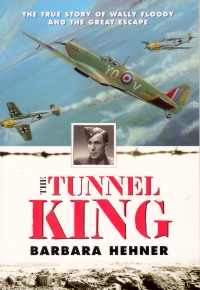| ________________
CM . . .
. Volume XI Number 5 . . . . October 29, 2004
excerpt: Flight Lieutenant Wally Floody was 25 years old, with dark hair and hazel eyes. He had been tall and lean to begin with. Prisoner-of-war rations, combined with the hard labour of digging tunnels, had left him gaunt and hollow-eyed. He had been buried alive several times before this and had felt the terror of suffocation. The best way out of Stalag Luft III, a prison camp for airman, seemed to tunnel under the barbed-wire. Wally knew how to build tunnels-so he would be back down tomorrow, and the next day, and he would keep digging. In The Tunnel King, Barbara Hehner tells the heroic story of Wally Floody, a young Canadian airman who had been shot down over Germany in 1941. It is a great story of an ordinary Canadian's great courage and determination in the face of overwhelming odds. Along with hundreds of Allied prisoners-of-war, Floody was a part of the attempted mass escape from a German prison camp, an escape which has since been immortalized in film and literature as the "Great Escape." Floody, readers learn, was a typical Canadian boy of the 1930s. He left school early because of the Great Depression, worked various hard-scrabble jobs, including a stint as an Alberta cowboy and hard rock miner in Northern Ontario, and rode the rails across North America. As war drew closer and closer, he decided he wanted to become a fighter pilot, and, at the first opportunity, he enlisted in the Royal Canadian Air Force (RCAF). Although flight training was demanding, Floody was determined to succeed. He received his wings, kissed his young bride good-bye and headed off to England to join a fighter squadron. His dreams of heroism turned out differently than expected as he was shot down and captured on his first combat mission. His wartime destiny lay in Stalag Luft III, and his time as a miner would serve him immeasurably. The Germans treated Floody and his fellow POWs reasonably, but, as Hehner relates, it was the POWs' duty to attempt escape and possibly return to England. The POWs schemed and used all their ingenuity to trick the German guards. However, tunneling under the wire seemed the best option for escaping. Because of his mining experience, Floody became an important digger, and he ensured that the tunnels, which would eventually be hundreds of feet in length, were as safe as he could possibly make them. As Hehner tells the story, the "Great Escape" was more of an act of defiance, bravado and propaganda than a solid escape plan. The leaders knew very few men had any real chance of making it from Germany to England, but it was worth the try. Readers learn the fascinating story concerning how identity cards and travel documents were forged, clothing was made and all the other intricate details that had to be thought out before any attempt could occur. Floody never got to participate in the planned mass escape because the Germans were suspicious of him, and so he was transferred to another camp. Sadly, as he later learned, all but three of the 76 escapees were recaptured, and, on direct orders from Hitler, the Gestapo murdered 50. Floody was repatriated to Canada at the end of the war and began his life anew as an ordinary Canadian citizen. However, in the 1960s, a Hollywood director approached him and asked if he would be the technical advisor on a film called The Great Escape that would star Steve McQueen, James Garner and Charles Bronson. The film would receive many honors and was named one of the top 50 adventure films by the prestigious American Film Institute. Floody died in 1987; he was a great Canadian. Recommended. Ian Stewart teaches at David Livingstone School in Winnipeg, MB.
To comment
on this title or this review, send mail to cm@umanitoba.ca.
Copyright © the Manitoba Library Association. Reproduction for personal
use is permitted only if this copyright notice is maintained. Any
other reproduction is prohibited without permission.
NEXT REVIEW |TABLE OF CONTENTS FOR THIS ISSUE - October 29, 2004. AUTHORS | TITLES | MEDIA REVIEWS | PROFILES | BACK ISSUES | SEARCH | CMARCHIVE | HOME |
